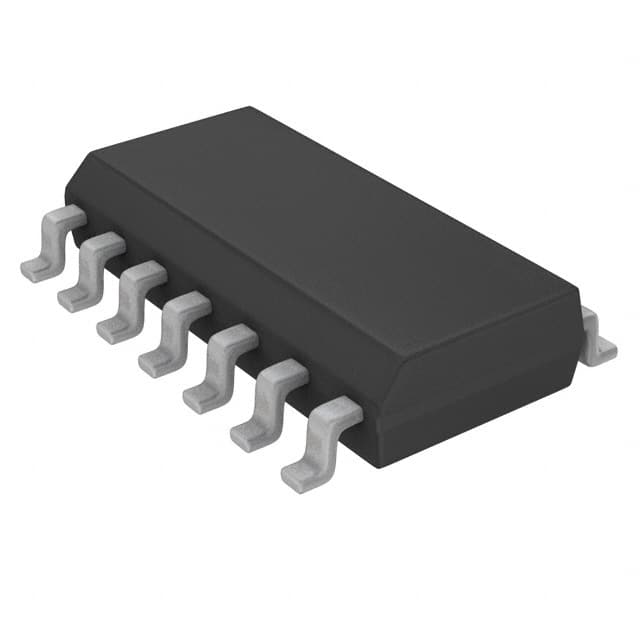PIC16LF18326-I/SL
Product Overview
- Category: Microcontroller
- Use: Embedded systems, control applications
- Characteristics: Low power consumption, high performance, small form factor
- Package: SOIC (Small Outline Integrated Circuit)
- Essence: A microcontroller designed for low-power applications with advanced features and functionality.
- Packaging/Quantity: Tray packaging, quantity depends on the order size.
Specifications
- Architecture: 8-bit
- CPU Speed: Up to 32 MHz
- Program Memory Size: 14 KB
- RAM Size: 1.5 KB
- Data EEPROM Size: 256 bytes
- Number of I/O Pins: 20
- ADC Channels: 11
- Timers: 3
- Communication Interfaces: UART, SPI, I2C
- Operating Voltage Range: 1.8V to 5.5V
- Temperature Range: -40°C to +125°C
Pin Configuration
The PIC16LF18326-I/SL microcontroller has a total of 20 pins. The pin configuration is as follows:
```
| | | 1 20 | |_______| ```
Pin Description: 1. VDD - Power supply voltage input 2. RA0 - General-purpose I/O pin 3. RA1 - General-purpose I/O pin 4. RA2 - General-purpose I/O pin 5. RA3 - General-purpose I/O pin 6. RA4 - General-purpose I/O pin 7. RA5 - General-purpose I/O pin 8. VSS - Ground 9. RC0 - General-purpose I/O pin 10. RC1 - General-purpose I/O pin 11. RC2 - General-purpose I/O pin 12. RC3 - General-purpose I/O pin 13. RC4 - General-purpose I/O pin 14. RC5 - General-purpose I/O pin 15. RC6 - General-purpose I/O pin 16. RC7 - General-purpose I/O pin 17. OSC1/CLKIN - Oscillator input 18. OSC2/CLKOUT - Oscillator output 19. MCLR/VPP - Master Clear/Voltage Programming Pin 20. VDD - Power supply voltage input
Functional Features
- Low power consumption: The PIC16LF18326-I/SL microcontroller is designed to operate efficiently with low power requirements, making it suitable for battery-powered applications.
- High performance: With a CPU speed of up to 32 MHz, this microcontroller offers fast and reliable processing capabilities.
- Small form factor: The SOIC package ensures a compact size, making it ideal for space-constrained designs.
- Advanced communication interfaces: The microcontroller supports UART, SPI, and I2C communication protocols, enabling seamless integration with other devices.
- Rich I/O capabilities: With 20 I/O pins, the microcontroller provides flexibility for connecting external components and peripherals.
- Robust temperature range: The operating temperature range of -40°C to +125°C allows the microcontroller to function reliably in various environments.
Advantages and Disadvantages
Advantages: - Low power consumption extends battery life in portable applications. - High-performance CPU enables efficient execution of complex tasks. - Small form factor facilitates integration into compact designs. - Versatile communication interfaces enhance connectivity options. - Ample I/O pins provide flexibility for interfacing with external devices. - Wide temperature range ensures reliable operation in harsh conditions.
Disadvantages: - Limited program memory size may restrict the complexity of applications. - Limited RAM size may impose constraints on data storage and manipulation. - Limited EEPROM size may limit non-volatile data storage capabilities. - Lack of built-in hardware encryption may require additional security measures for sensitive applications.
Working Principles
The PIC16LF18326-I/SL microcontroller operates based on an 8-bit architecture. It executes instructions stored in its program memory, which can be programmed using various development tools and programming languages. The CPU processes data and controls the operation of peripherals and I/O pins.
The microcontroller can communicate with external devices through its UART, SPI, and I2C interfaces. It can read analog signals using its built-in ADC channels and generate digital outputs through its I/O pins. The microcontroller's low power consumption allows it to operate efficiently in battery-powered applications.
Detailed Application Field Plans
The PIC16LF18326-I/SL microcontroller is suitable for a wide range of applications, including but not limited to:
- Home automation systems
- Industrial control systems
- Internet of Things (IoT) devices
- Medical devices
- Automotive electronics
- Consumer electronics
- Robotics
- Sensor networks
- Smart agriculture systems
- Energy management systems
Alternative Models
- PIC16LF18325-I/SL
قم بإدراج 10 أسئلة وإجابات شائعة تتعلق بتطبيق PIC16LF18326-I/SL في الحلول التقنية
Question: What is the maximum operating frequency of PIC16LF18326-I/SL?
Answer: The maximum operating frequency of PIC16LF18326-I/SL is 32 MHz.Question: Can PIC16LF18326-I/SL be used in battery-powered applications?
Answer: Yes, PIC16LF18326-I/SL is suitable for battery-powered applications due to its low power consumption.Question: Does PIC16LF18326-I/SL support analog-to-digital conversion (ADC)?
Answer: Yes, PIC16LF18326-I/SL features a 10-bit ADC module.Question: What communication interfaces are supported by PIC16LF18326-I/SL?
Answer: PIC16LF18326-I/SL supports SPI, I2C, and UART communication interfaces.Question: Is PIC16LF18326-I/SL suitable for motor control applications?
Answer: Yes, PIC16LF18326-I/SL can be used for motor control applications with its PWM and capture/compare/PWM (CCP) modules.Question: What is the operating voltage range of PIC16LF18326-I/SL?
Answer: PIC16LF18326-I/SL operates within a voltage range of 1.8V to 5.5V.Question: Can PIC16LF18326-I/SL be programmed using C language?
Answer: Yes, PIC16LF18326-I/SL can be programmed using the MPLAB XC8 C compiler.Question: Does PIC16LF18326-I/SL have built-in EEPROM memory?
Answer: Yes, PIC16LF18326-I/SL includes 256 bytes of EEPROM memory.Question: What development tools are available for PIC16LF18326-I/SL?
Answer: Development tools such as MPLAB X IDE and MPLAB Code Configurator support PIC16LF18326-I/SL.Question: Is PIC16LF18326-I/SL suitable for temperature sensing applications?
Answer: Yes, PIC16LF18326-I/SL can be used for temperature sensing applications with its analog and digital peripherals.


